Building Mathematics: Sculpture system No. 5
[Update 15/1/10: More pictures (in the snow!) now up]
[Update 16/3/10: A second sculpture built in Newcastle]
[Update 13/5/10: Volcanic background]
Can you get children and young people to build mathematical scultptures in their own time?
Last week I did. We created this strange object in the lava of a volcanic island on the boundary between America and Europe.
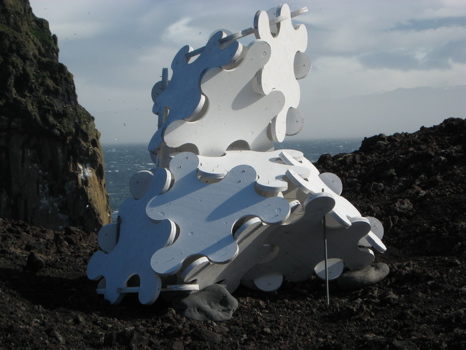
Crowdsourced mathematical art
The design, Sculpture System No. 5, by Richard Grimes, and far more details of construction are available here. The goal is to open this idea to the crowd and see where it is taken, crowdsourcing art. There is already one other write up. Without further ado, here is my take on events.
If you have never heard of Fab Labs take a look, they are amazing. I came across one by chance on the small island of Heimaey in the North Atlantic. Luckily for me the guy in charge, Smári McCarthy had a liking for mathematics and asked if I could teach something to the people using the facilities. When you get an opportunity like that to try to corrupt kids into mathematics you cannot turn it down. Well I cannot.
The question was what to do? Tilings are nice and produce great images, but they are a little flat. Building something in three dimensions is far more exciting. The idea that came to me was to make a giant version of Polydron. If you have not come across this wonderful product look into it now, especially if you are a teacher. It works best if it just left around so people can start to play on their own terms. Even primary school children can pick it up, play and discover, yet it also holds the interest of many research geometers.
The essence of polydron is regular shapes hinging together. With these you can build anything. I started sketching some ideas in my head, but I am not a natural at building objects. Luckily one of my inspirations for the polydron idea was on hand. My friend Richard Grimes had been working independantly on similar systems and deltahedra for many years, creating everal sculptural systems, individual objects that can be put together in many different forms. He is also a great craftsman, so he was able to create a design that was simple, elegant and beautiful, not to mention easy to put together. He named it “Sculpture system No. 5”.
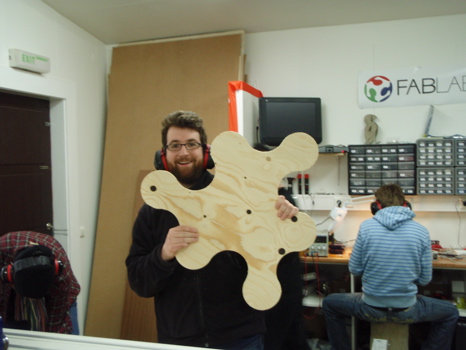
The basic tile
The question was what could we build that was artistically satisfying to me, taught some maths and involved people in the design rather than just as donkey work for the construction. As I am writing this in hindsight, of course these are also goals that were achieved!
For constraints we obviously want to minimise the number of shapes used. The simplest shapes are triangles, the polyhedra built from them deltahedra. I decided that twenty was a good number, it is the number you need for a regular icosahedron. The next step was to get people involved. Polydron is the natural tool for this, and as soon as I brought it to the lab it was sucked up, without even being pointed out to people. However to give some freedom to the construction the common maths art fare of highly symmetric figures would not work. There are not enough of them. In addition, because of the symmetry, they offer the same view from many directions, which is a little boring. So I went to the other extreme. Build figure with no symmetry. With 20 tiles this is not easy, and spotting symmetries is a great exercise. So several groups of children took up the project and we had four different designs. All of which I would have been happy to build. Before construction everyone voted on the final design.
We then fired up the machines and started cutting the tiles, I will let pictures tell the rest of the story:
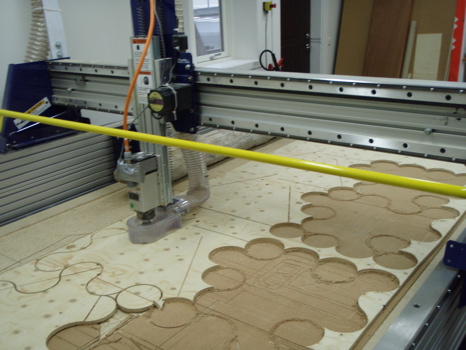
Cutting things out
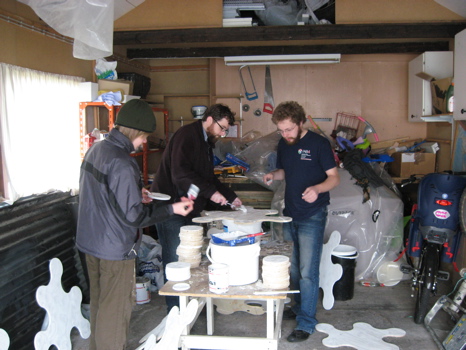
Painting the tiles
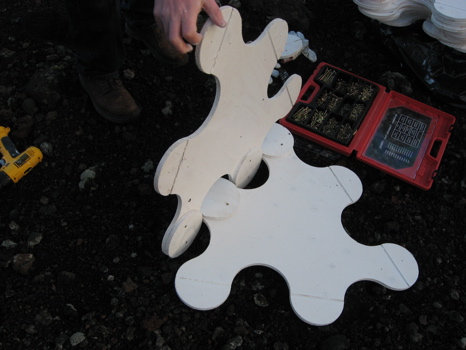
A basic hinge

Construction
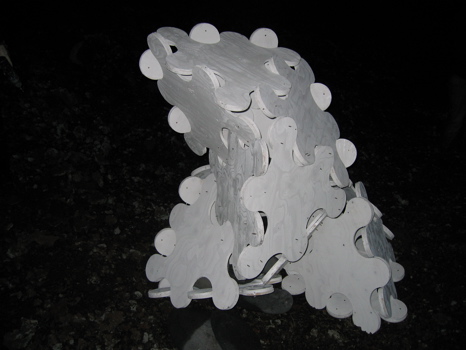
Complete!
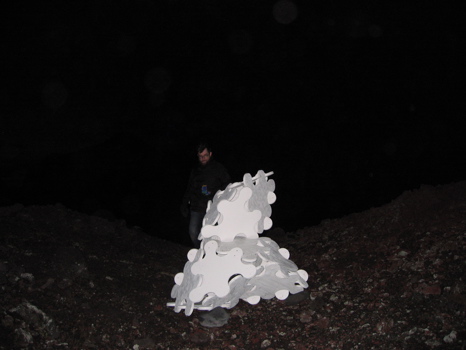
A ghost in the dark
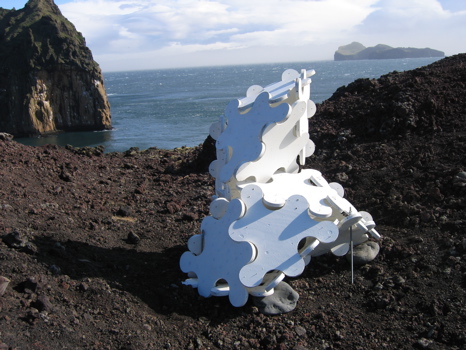
Next morning

Pingback: The Math Factor Podcast » Harriss: Mathematical Sculpture
Quite intriguing– is the basic unit a triangle with notches, but then because of additional “combinatorial symmetry”, the unit need not fit “putative edge” to “putative edge”?
Exactly. Which means cutting them out leaves very little waste wood. That is a good thing. Wood is not native to Iceland, and so expensive.
How does the hinging system work: what’s holding the pieces together? Can kids do the assembly?
There is a rod held in place by an additional circle that is screwed into place. Kids did the assembly, but under supervision. Closing the sculpture up is slightly harder, but just needed a little thought. We plan to put full details up including the files to cut. Hopefully in a day or two.
Pingback: Webmind’s blog » Blog Archive » SculptureSystem5
Wow! This gives me some great ideas for a new mathematical quilt—that is as soon as I get done with the next 3 ideas I am working on. Very interesting and you have done a great job of documenting the entire project. Keep up the awesome work! Elaine, mathematical quilter
Lovely!
But I’m still unable to make out why the sculpture gets a twisted figure. It is understandable that it is because of the hinges but even after support (the rod), it is twisted?
Also, Thanks for all those links. They are very informative.
Anand, there is a sort of twist on each tile to allow them to lock together. You can see how a triangle becomes this tile here:
http://www.fablab.is/w/index.php/Sculpture_System_No._5_blocks
Other than that the figure is just a regular delathedron.
Thanks! Sometimes I think I should also undertake such activities here but not many people are interested.
You would be surprised. People love building things! You can sneak the maths in 😉
Pingback: Carnival of Mathematics #52 « The Number Warrior
Great stuff!! Loved the work, the links and the spirit, congratulations!!
If I’d had math&arts teachers like you I wouldn’t be a sociologist today!!!
I think your article answered my questions…..wonderful piece….!!!!
Pingback: Natural and Maths Sculpture « Maxwell’s Demon
Pingback: Recent and current projects « Maxwell’s Demon
Pingback: Building Mathematics: The Maker Faire in PIctures « Maxwell’s Demon
Pingback: Building Projects « Maxwell’s Demon
Awesome, I’d like to build one those too with my kids.. any instructions on how to do it?
You actually make it seem so easy with your presentation but I find this topic to be actually something that I think I would never understand. It seems too complex and extremely broad for me. I’m looking forward for your next post, I will try to get the hang of it!
If not for your wtriing this topic could be very convoluted and oblique.